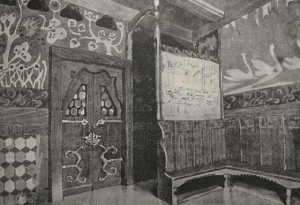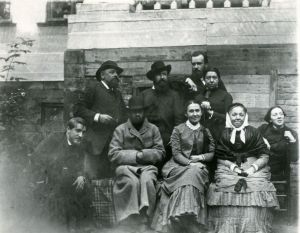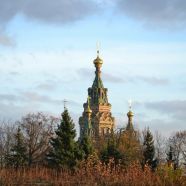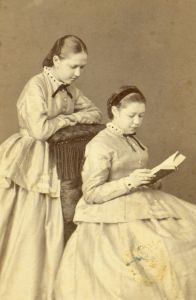Russian Land as the Greatest Artistic Inspiration
Russian art has a continuous connection to the land. Many painters, such as Alexey Venetsianov and Vasily Tropinin, sought to create paintings that would express their devotion to the place in which they were born and raised and to the people whose connection with the soil was both material and metaphorical—the peasants. Overall, some might say that the greatest influence of the land on Russian art can be found in its folklore and traditions; these provided a great inspiration for the artists of the late nineteenth century. When looking at the Arts and Crafts movement in Russia, the ties that unite the land and its artistic inhabitants are clear and strong.
The Arts and Crafts movement was first proclaimed in Britain in the late nineteenth century as an opposition to the industrialization and mechanization of design and decoration. To meet this challenge, artists revived long forgotten folk patterns and introduced new forms that were substantially different from standardized industrial products. The movement rapidly spread to many Western countries where the idea of creating a beautiful environment devoid of mass-produced designs was warmly accepted by artists. The similarities between many independent branches of the Arts and Crafts movement could be found in organizational methods, but the Russian variant was even more deeply influenced by the land’s folklore and peasants’ traditional craftsmanship.
The American Arts and Crafts movement, like its British predecessor, was grounded in William Morris’s critique of what he felt had become a dehumanized art that was an extension of the Industrial Revolution and mechanization of labor. Workshops, schools, and training programs were opened around the country to provide training for people willing to elevate design to enrich their lives through simple, beautiful craftwork. Societies like the Saturday Evening Girls Club in Boston were opened to give people a chance to sell their everyday functional works such as pottery, within the community. In the winter of 1894–1895, Newcomb Pottery was formed in New Orleans, producing ceramics, metalwork, and textiles inspired by Southern natural forms. This for more than simple commercial purposes and embraced the important ideas of the Arts and Crafts movement. The end of the movement came by the 1920s with the continued rise of urban centers, increased growth in machine culture, and the complex social and economic changes in American national identity and society.[i]
The Russian Arts and Crafts movement was tightly connected to Elena Dmitrievna Polenova, whose art reflected both the beauty of the land and her exceptional talent. Polenova was born to a noble family in 1850 in Saint Petersburg six years after her brother Vassily Dmitrievich, who also became a famous landscape painter. The two children were raised in the Russian Orthodox faith with a strong belief in mercy and the desire to unconditionally help people in need. As a child, Elena Polenova was inspired by her grandmother Vera Nikolaenva Voyeikova who was very fond of history, fairytales, and culture. She taught her grandchildren to love the national traditions and to respect the place in which they were born. This formed Polenova’s perception of art and later appeared in her works, which bore a strong resemblance to the nature of the Motherland.

A. Golovin, E. Polenova. The project of a dining room for Maria F. Yakunchikova’s residence by the river Nara, 1898-1899.
Polenova’s fascination with traditional Russian ornaments spread to various art forms that she regularly practiced, such as pottery and painting, and developed into a notable project with artist Aleksandr Golovin, where they designed a dining room for Maria F. Yakunchikova’s residence by the river Nara. The design, which featured the national traditional decorative elements, attracted Netta Peacock, a British journalist, who later expressed her great admiration of their work in an article for the magazine The Artist: “The curious mixture of the North and the Orient, which is so strikingly contrasted in all things Russian, makes their music, art and literature specially interesting to the student of history, who is able to trace the different influences at work in their very personal way of expressing themselves, be it in sound, form and colour, or in the very subtle analysis of the life and character to be found in their best authors. The number of legends, the countless superstitions still rife among the peasantry, provide abundant material for artistic expression.”[ii] Peacock introduced the Western audience to the unique and distinctive style of Russian artists which combined the fascination with natural wonders with beloved fairytales. Polenova’s designs also interested Wallace Crowdy, editor of The Artist, to whom Peacock refers in her letter to Elena Polenova from July 6, 1898: “He can give no definite answer about your other designs without seeing some of them, so I want you to send me one or two of the carved wood and one or two of the Embroideries. Ever such rough sketches will do, he can judge of their value, but please pick out the most Russian—he loves the Oriental influence in Russian design and colour.”[iii] In Britain, the new designs introduced by Polenova were suitable for the principles of the Arts and Crafts movement set against the mass production of standardized design items, thus the audiences liked Polenova’s work. The artist herself wanted to visit Britain to see where the Arts and Crafts movement originated, but she never managed to do so.[iv]

E. Polenova (first on the right in the upper row) surrounded by her friends and family in Abramtsevo, 1883.
Another side of Elena Polenova’s devotion to Russian folk culture and her native land can be found in her involvement in the activities of the Abramtsevo circle. When Elizaveta Grigorievna Mamontova, the wife of a famous Russian industrialist, merchant, and patron of arts Savva Mamontov, opened workshops for the local peasants and their children to study traditional crafts, Polenova helped bring this idea to life. Abramtsevo, the Mamontovs’ estate, by that time had become the center of Russian cultural life, attracting the names of the famous Valentin Serov, Konstantin Korovin, and many others. The artists gathered a great collection of folk art, which inspired them to add elements of the Russian culture into their masterpieces and discover something new in the seemingly well-known nature of the land. The creations from these workshops were later sent to Moscow to be sold in order to benefit the peasantry. Polenova and Mamontova were determined to find the best examples of the traditional crafts which would be successfully sold in the capital, so they searched for the designs in local villages, collecting a great number of unique pieces of wooden cutlery and ceramic pottery. Polenova, a great admirer and producer of ceramics herself, wanted to bring back long-forgotten designs and create something inspiring for the people when looking back at their land’s history. Unfortunately the ideas which she bore in mind could not be fully realized as the artist died at the age of forty-seven in Moscow after a long and tiring illness,. The special note in The Artist later said of Polenova: “sister to Russia’s greatest modern painter, her very own remarkable gifts placed her at the head of Russian decorative art.”
We see the land, Russian folk culture, and the peasantry as endless sources of inspiration bringing life to various forms of art and culture which are unique and inimitable by machinery. Elena Polenova provides a model example of what unconditional love of the land can produce and how many wonders we still have to discover about the country and its people. Her artistry reintroduced striking forms of creativity and imagination through innovative designs. The Russian and international variants of the Arts and Crafts movement as a whole have highlighted connection to nature, folk traditions, and cultural heritage which should be recognized and valued by generations to come.
[i] Monica Obniski, “The Arts and Crafts Movement in America,” in Heilbrunn Timeline of Art History (New York: The Metropolitan Museum of Art, 2000).
[ii] Netta Peacock, “A Log House Dining Room,” The Artist no. XXIV (1899), p. 9.
[iii] Letter from N. Peacock to E. Polenova, 6th July, 1898.
[iv] The correspondence between Polenova and Peacock, which is stored at the archive of the Russian State Tretyakov Gallery in Moscow, shows the details of the trip that was meant to be done some time after their acquaintance. The friendship of the women with Maria Vasilievna Yakunchikova-Weber, another great Russian artist who spent the majority of her life abroad, can also be traced. Yakunchikova-Weber was born in 1870 and became close to the Polenov family around 1886. The influence of Elena Polenova had inspired Yakunchikova-Weber to discover more about the land and use its generosity of natural wonders in her artistic expression. The two remained close friends until Polenova’s death in 1898.








